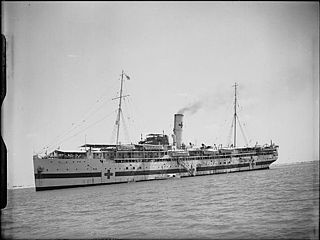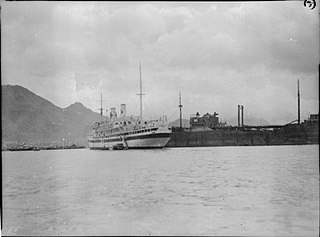HMHS is an acronym for His/Her Majesty's Hospital Ship.
HMHS is an acronym for His/Her Majesty's Hospital Ship.
The earliest record of British hospital ship was Goodwill, which briefly accompanied a Royal Navy squadron in the Mediterranean in 1608 or 1609. [1] [2] From 1665 the Royal Navy formally maintained two hospital ships at any time, these being either hired merchant ship or elderly sixth rates, modified from their original design by the removal of internal bulkheads and addition of ports cut through the deck and hull for ventilation. The limit of two hospital ships at a time remained in place until the Nine Years' War at century's end. In 1691 there were four hospital ships in service, rising to five in 1693 and six in 1696. [1]
In addition to their sailing crew, these seventeenth century hospital ships were staffed by a surgeon and four surgeon's mates. Standard medical supplies were bandages, soap, needles and bedpans, and patients were issued with a clean pair of sheets. Infectious patients were quarantined from the general population behind a sheet of canvas. The quality of food was very poor. In the 1690s the surgeon aboard Siam complained that the meat was in an advanced state of putrefaction, the biscuits were weevil-ridden and bitter, and the bread was so hard that it stripped the skin from patient's mouths. [1]
| Vessel name | Tons burthen | Guns | Crew | Hospital service |
|---|---|---|---|---|
| Goodwill | not recorded | not recorded | not recorded | 1608 or 1609 |
| Joseph | 101 | 4 | 30-40 | 1665 |
| Loyal Catherine [lower-alpha 1] | 298 | 36-40 | 35 | 1665-1666 |
| Maryland Merchant | not recorded | 41 | 40 | 1666 |
| John's Advice | 330 | 16 | 40-54 | 1672-1674 |
| Unity | 118 | 6-8 | not recorded | 1683 |
| Welcome | 78 | 10 | not recorded | 1683 |
| Helderenberg | 242 | 18-30 | 50 | 1688 |
| Concord | 352 | 22-30 | 45 | 1690-1695 |
| Society | 357 | 22-30 | 45 | 1690-1697 |
| Baltimore | 300/324 | 20 | 45 | 1691 |
| Spencer | 245 | 20 | 40-45 | 1691 |
| London Merchant | 250 | 22-30 | 30-45 | 1692-1696 |
| Siam | 333 | 22-30 | 45-58 | 1693-1697 [lower-alpha 2] |
| Bristol | 532 | 20 | 40-45 | 1692-1694, 1696-1697 |
| Josiah | 664 | 30 | 30 | 1696 |
| Muscovy Merchant | 250 | 24 | 45 | 1696 |
| London Merchant | 250 | 22-30 | 30-45 | 1692-1696 |
| Vessel name | Tons burthen | Guns | Crew | Hospital service |
|---|---|---|---|---|
| Lewis | 460 | 42 | 50 | 1701 |
| Suffolk (frigate) | 477 | 8-30 | 50-70 | 1701, 1713 |
| Siam | 333 | 2-30 | 45-58 | 1702-1703 [lower-alpha 2] |
| Antelope | 550 | 24-30 | 60-83 | 1702-1703, 1706-1708 |
| Princess Anne | 484 | 24-30 | 70-83 | 1702-1706 |
| Jeffreys | 513 | 20-26 | 60-73 | 1702-1708 |
| Sarah and Betty | 370 | 24 | 45-58 | 1702-1703 |
| Smyrna Factor | 355 | 24 | 45-50 | 1702-1703, 1705-1709 |
| Suffolk (hoy) | not recorded | 10-30 | 80 | 1703-1704 |
| Matthews | not recorded | not recorded | 50-60 | 1705-1708 |
| Martha | not recorded | 22 | 70-80 | 1707-1710 |
| Leake | not recorded | 14 | 50-80 | 1708-1711 |
| Arundel | not recorded | not recorded | not recorded | 1709 |
| Pembroke | not recorded | 28 | 60-95 | 1709-1713 |
| Delicia | not recorded | 22 | 63-65 | 1710-1713 |
| Looe | 553 | 12-42 | 60 | 1717-1718 |
| Portsmouth | not recorded | not recorded | not recorded | 1731 |
| Princess Royal | 541 | 18 | 77 | 1740-1741 |
| Scarborough | 501 | 18 | 60 | 1740-1744 |
| Jersey | 1065 | 60 | not recorded | 1771-1779 |
| Nabob | 637 | 26 | 72 | 1779-1783 |
| Lioness | 711 | 26 | 72 | 1780-1783 |
Royal Fleet Auxiliary hospital ships:

A hospital ship is a ship designated for primary function as a floating medical treatment facility or hospital. Most are operated by the military forces of various countries, as they are intended to be used in or near war zones. In the 19th century, redundant warships were used as moored hospitals for seamen.

The Royal Fleet Auxiliary (RFA) is a naval auxiliary fleet owned by the UK's Ministry of Defence. It is a component of His Majesty's Naval Service and provides logistical and operational support to the Royal Navy and Royal Marines. The RFA ensures the Royal Navy is supplied and supported by providing fuel and stores through replenishment at sea, transporting Royal Marines and British Army personnel, providing medical care and transporting equipment and essentials around the world. In addition the RFA acts independently providing humanitarian aid, counter piracy and counter narcotic patrols together with assisting the Royal Navy in preventing conflict and securing international trade. They are a uniformed civilian branch of the Royal Navy staffed by British merchant sailors. The RFA is one of five RN fighting arms.
Three vessels of the British Royal Navy have been named HMS Lysander, after Lysander, a military commander of ancient Sparta.

The British Pacific Fleet (BPF) was a Royal Navy formation that saw action against Japan during the Second World War. It was formed from aircraft carriers, other surface warships, submarines and supply vessels of the RN and British Commonwealth navies in November 1944.

HMS Trincomalee is a Royal Navy Leda-class sailing frigate built shortly after the end of the Napoleonic Wars. She is now restored as a museum ship afloat in the National Museum of the Royal Navy, Hartlepool, England.

A landing ship, infantry (LSI) or infantry landing ship was one of a number of types of British Commonwealth vessels used to transport landing craft and troops engaged in amphibious warfare during the Second World War. LSIs were operated by the Royal Navy, British Merchant Navy, Royal Canadian Navy, Royal Indian Navy, and Royal Australian Navy. They transported British Commonwealth and other Allied troops in sea assaults and invasions throughout the war.

HMHS Llandovery Castle, built in 1914 in Glasgow as RMS Llandovery Castle for the Union-Castle Line, was one of five Canadian hospital ships that served in the First World War. On a voyage from Halifax, Nova Scotia to Liverpool, England, the ship was torpedoed off southern Ireland on 27 June 1918. The sinking was the deadliest Canadian naval disaster of the war. 234 doctors, nurses, members of the Canadian Army Medical Corps, soldiers and seamen died in the sinking and subsequent machine-gunning of lifeboats. Twenty five people are known to have survived. 24 were the occupants on a single life-raft. The incident became infamous internationally and was considered, after the Armenian genocide, as one of the war's worst atrocities. After the war, the case of Llandovery Castle was one of six alleged German war crimes prosecuted at the Leipzig trials.

Royal Naval Hospital (Hong Kong) was the Royal Navy's medical facility in the colony.
John Morley Holford, CB, OBE was a medical officer in the Royal Navy.
Surgeon Vice Admiral Ian Lawrence Jenkins was a Royal Navy medical officer and former Surgeon General of the British Armed Forces.

Royal Fleet Auxiliary ship Maine was a hospital ship of the British Royal Fleet Auxiliary, that served during the First World War and the Second World War.

RFA Maine was a 7,432 GRT hospital ship which was built in 1924 as the ocean liner Leonardo da Vinci by SA Ansaldo, La Spezia, Italy for the Società di Navigazione Transatlantica Italiana. In 1941, she was captured by the British at Kismayu, Italian Somaliland. Declared a prize of war, she was passed to the Ministry of War Transport (MoWT) and renamed Empire Clyde, serving as a hospital ship for the British Army during the Second World War. In 1948, ownership was passed to the Admiralty and she entered service with the Royal Fleet Auxiliary as RFA Maine. She served during the Korean War and was scrapped in 1954.

HMHS Glenart Castle was a steamship originally built as Galician in 1900 for the Union-Castle Line. She was renamed Glenart Castle in 1914, but was requisitioned for use as a British hospital ship during the First World War. On 26 February 1918, she was hit and sunk by a torpedo fired from the German U-boat UC-56.
The Maritime history of Scotland involves events including shipping, ports, navigation, and seamen, as well as marine sciences, exploration, trade, and maritime themes in the arts of Scotland.

Surgeon Rear Admiral Lionel John Jarvis, CBE, KStJ, QHS, FRCR, DL is a British consultant radiologist. He was previously the Surgeon General of the Royal Navy and the Assistant Chief of the Defence Staff for Health. He served as the Royal Navy's Chief Medical Officer and Medical Director General (Naval) until April 2012. He was appointed as an Honorary Surgeon to the Queen (QHS) in 2006. He was both the Prior of England and the Islands of the Most Venerable Order of the Hospital of Saint John of Jerusalem and the Chair of St John Ambulance from 2016 to 2021.